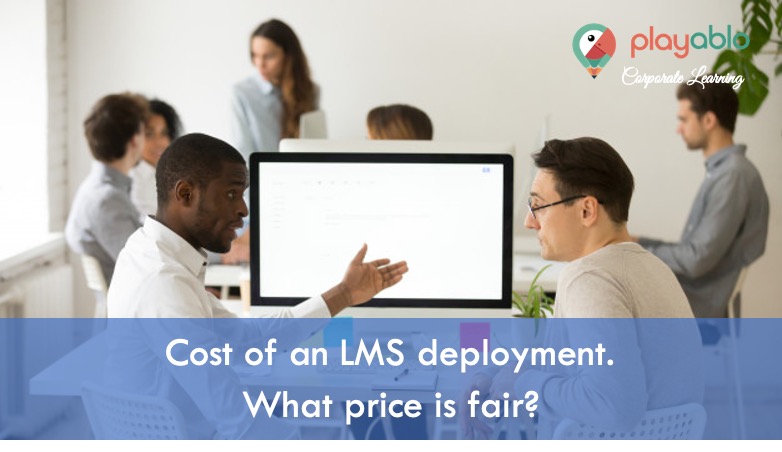“Pricing is the exchange rate you put on all the tangible and intangible aspects of your business. Value for cash” – Patrick Campbell. True, right? When we say ‘pricing,’ you should know that it applies to your company’s segment. And this applies to your Learning Management System (cost of LMS) as well. An LMS is a considerable expense, which MUST yield good Return on Investments. Although learning drives innovation, growth, and taps into unrealised revenues, it does have a price tag!
But why to fear when we are here? First and foremost, let’s get this fact straight. Moving to an online learning platform always has a positive impact on your L&D budget. However, before considering the long-term cost benefits, we understand that you would be concerned about the upfront costs. And the first-time implementation price of an LMS does indeed seem intimidating.
Table of Contents
First-Time Cost of LMS: Where to Begin?
Now, here are some wise words. Before you begin to panic after glancing at the numbers, take a step back and analyse your existing costs, incurred due to current problems. For instance, you might have owned a refrigerator for ages. But now, the food you store there has started to get spoiled. So, yes, after a specific span, you do not need to stay faithful to your old stuff! It’s better to replace it.
Therefore, how to get started? First up, figure out the cost of LMS associated with the current issue. Secondly, calculate the expenses incurred in implementing the new solution. When you have both these figures on paper, it will be much easier to convince your management. Once you have identified the actual expenses connected to your current model, it’s simpler to browse through the various LMS platforms — and pick one that best suits your needs.
Read More: How to Select an LMS in 2021: Your Step-by-step Guide
Calculating Your Current Costs

Let’s assume that you already have a corporate training system in place. It might either be boosting profits or wasting resources. You may be disseminating knowledge. But are your employees retaining the learning? Is your staff successfully applying it in their job profiles? Worse still, if the training sessions are offline and do not follow a methodology, you are necessarily wasting money and time on travel, lost Google Docs, slide decks, and monotonous learning sessions.
Inadequate training can additionally lead to an unsatisfactory user experience. A lousy customer deal can translate to failed business partnerships, which negatively affects the revenue flow. The perfect partner, customer, or employee training leads to the maximum value addition.
So, how do you give an actual number of cost of LMS to your current obstacles?
Start by asking these questions. If you invest in a new training program, how much additional revenue can you draw from your clients? What’s the current turnover rate – thanks to low engagement and a poor user experience? How much cash do you lose when you lose an employee or partner? What’s the time consumed in administering this platform each week. The total hours include enrollments, reporting, creating content, uploading content, sending notifications, and sending out materials, among others?
Ad: PlayAblo’s Enterprise-Grade Micro-Learning platform is for the modern corporate learner. Micro-Learning, along with assessments and gamification features, ensures learning outcome measurement along with sustained engagement.
Find out more and request a custom demo!
Do you have an instructor-led training program in place? Have you considered the costs incurred on travel arrangements for onsite sessions? What’s the success rate of your existing training program? Can you measure the outcomes via quantifiable analytics? Finally, if your current platform does not meet learner needs, what alternatives do they pick to bridge the gap? Are you spending resources on a new program?
Once you have the answers to all of the questions mentioned above, you should see if an automated learning program will solve them. Each of the aspects, as mentioned earlier, has revenues attached to them. Hence, you should take them into account while deciding how much to spend on LMS software. A thorough cost analysis of the problem is necessary before you go ahead and check out the cost of LMS.
The end result?
When you do the required research and pick the perfect LMS like PlayAblo, you can keep your customers and partners engaged while receiving more value in your products and services. Even on the internal front, full-fledged and targeted training sessions will keep employees devoted to your organisation. To wrap it up, once you solve your current issues by opting for a new solution, you save money. Your revenue will witness a boost, coupled with increased productivity, higher job satisfaction, and successful business relationships.
The BOTTOMLINE: CRUNCH SOME NUMBERS! THE ANSWERS WILL REFLECT INSTANTLY!
Next Up
What Are the Different Types of LMS Pricing Models?

Each LMS vendor provider follows a typical cost of LMS pricing model based on the number and complexity of features. For instance, the pay-per-user model demands users to pay for the LMS platform regularly — whether they use it or not. On the other hand, pay per registered user models, as the name suggests, follow a similar pricing structure as SAAS AKA Cloud LMS space. What happens here is, organisations need to pay for the LMS according to the number of users who have a login and password. However, it does not necessarily mean that all of the users are consuming the content.
Finally, the pay per active user model is the most economical cost of LMS structure. Why? It only demands payment for the people who use it. Yes, the LMS pricing models differ, depending on the vendor. And you can understand the costing structure by looking at the billing cycle or charge per month per active user.
Additional LMS Pricing Models
Another pricing model to calculate the cost of LMS is the pay per course. The name makes the plan pretty straightforward – you pay each time a learner enrols in a course. Usually, compliance-heavy industries, which rely on certification courses, opt for this model. On the other hand, open-source LMS models arrive with zero upfront cost. However, you need to incur additional expenses towards coding, programming, and deploying a team holding HTML expertise. Moreover, several LS providers require a license fee, including limited features, support, and a certain number of users.
Additional Factors to Consider While Calculating Cost of LMS
Apart from the LMS pricing model, you need to check the additional expenses related to an online training platform. Several LMS vendors offer onboarding and customer support services, included in their tiered pricing. Of course, you must also consider the set-up fee involved in implementing and running a new system.
Think about content migration. When you already have a learning platform in place, you will own a gamut of valuable assets. So do you have the option to transfer your legacy content to the new LMS? Accordingly, ask your provider about the charges associated with this service.
Read More: Your Go-to Guide to Convert PPT to Mobile Learning
Finally, to arrive at the cost of LMS, consider the features included in the cost of LMS. Does your new solution offer integrations? If yes, check for the popular integrations — e-commerce, single sign-on AKA SSO, web-conferencing, and live classes. Web-conferencing and live-classes make it easier to host virtual events, webinars, and meetings directly within your learning platform, in real-time.
Read More: Integrating LIVE Classes in your LMS
Additionally, content authoring tools enable you to be effortless in distributing and replicating learning materials across multiple courses. The ability to integrate with HCM & HRIS renders user provisioning benefits. The HCM can then serve as a single source for user data, giving you valuable information such as profitability, career development, employee satisfaction, and retention. Moreover, integrated customer relationship management tools allow your sales teams to absorb knowledge practical regarding their job profiles.
Gamification elements in PlayAblo make learning an engaging experience by including competitions, badges, rewards, and leaderboards. On the other hand, integration with extended enterprise gives you the option to offer courses to partners and customers — thereby, boosting your profit margin. It leads to more users, customisation, and functionality.
Ad: PlayAblo’s Enterprise-Grade Micro-Learning platform is for the modern corporate learner. Micro-Learning, along with assessments and gamification features, ensures learning outcome measurement along with sustained engagement.
Find out more and request a custom demo!
A mobile-optimised LMS software enables your audience to consume content on-the-go – on an iPhone, Android, or iPad. It allows learners to learn in real-time, no matter where they are located. Finally, integration with social learning modules takes advantage of the virtual, social-media-centric audience. It keeps learners engaged and encourages them to collaborate and share ideas across the world.
Wrapping it Up
Finally, when you calculate the cost of LMS, have a look at the agreement length — which usually ranges from one to five years. We would advise you to seek the middle ground, i.e. a three-year-contract — since a shorter-term translates to a price increase soon. Again, go for a longer-term when you have complete faith in your vendor and want to develop a lasting partnership—summing it up! Since you now have a detailed understanding of the different pricing models and added costs, it is time to kickstart the shopping process. All the best!







This is the perfect blog for anybody who hopes to find out about this topic.
You definitely put a brand new spin on a topic which has been discussed for decades. Wonderful stuff, just excellent!